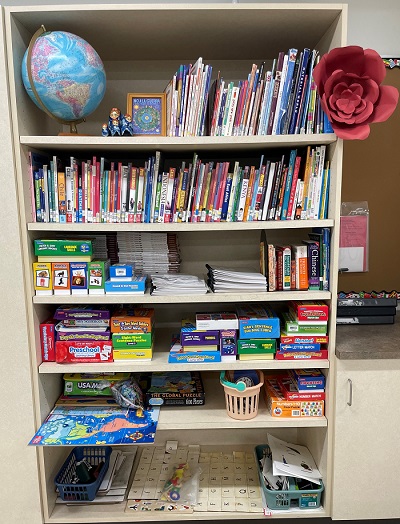- MN ABE Connect
- Archive
- Manipulatives Are a Fun and Engaging Way to Help ESL Students Learn! – Part 1
 March 18, 2022
March 18, 2022
Manipulatives Are a Fun and Engaging Way to Help ESL Students Learn! – Part 1
Miriam Bosveld, Teacher and PANDA ConsultantMiriam Bosveld, a Level 1 ESL teacher at the Robbinsdale Adult Academic Program and a PANDA consultant, wrote the following article series about the relevance of using manipulatives in teaching her students. Using manipulatives is also supported in the Universal Design for Learning (UDL) free training that PANDA offers each year.
Manipulatives in the ESL classroom
I love my Level 1 ESL classroom. It’s spacious, bright, and colorful. Several years ago I had a group of crafty students who decorated my room with hand-made paper flowers. The flowers are a visible sign of learning, community, and a relaxed atmosphere.
Also, a sign of learning, community, and relaxation, is my bookshelf! It’s full of games, books, cards, puzzles, maps, numbers, clocks, and photos.
 Technically, these are called manipulatives – physical objects that students can manipulate to enhance learning. Sometimes we classify manipulatives as “just a game” or “something kind of fun.” I believe that manipulatives play an important role in the classroom, especially at the lower levels. And, it’s not just the actual manipulative. It’s the fact that manipulatives are usually done in small groups or pairs.
Technically, these are called manipulatives – physical objects that students can manipulate to enhance learning. Sometimes we classify manipulatives as “just a game” or “something kind of fun.” I believe that manipulatives play an important role in the classroom, especially at the lower levels. And, it’s not just the actual manipulative. It’s the fact that manipulatives are usually done in small groups or pairs.
Learning
Manipulatives enhance and reinforce learning. I try to include a manipulative in every lesson. I can usually create a hands-on activity for every lesson. For example, I try to make a simple categorization activity for
Grammar lessons:
- Students can decide if words are nouns or verbs
- They can categorize singular and plurals
- They can decide if a sentence is in the future or the past
- They can separate sentences into correct English sentences and incorrect English sentences
- They can match sentences to punctuation marks
Reading lessons also lend themselves to manipulative activities:
- You can cut a text into sentences
- Mix the sentences up
- Ask the students to put the sentences in order
- You can cut sentences in half and ask students to match them
- You can provide words and ask the students to form sentences
- Literacy Level students can put the ABCs in order and match sounds to letters
The possibilities are endless! It’s a lot of cutting, but if you laminate you can re-use them.
We hear a lot about “productive struggle.” The idea is that students should struggle a little – but not too much – to learn. Manipulatives are perfect for this because you are providing materials and students have some ideas as to what you might want them to do.
One of my favorite things to do is present a manipulative with no directions. The first time you do this the students might look a little surprised. But, if you do this regularly they get used to figuring out what they should do based on the materials you’ve given them. And if one group just can’t figure out what to do, send them over to a group that does know what to do! Teachers DO NOT need to talk as much as we think we do.
Some of the beauty of manipulatives is their simplicity. Just this year, I started a new manipulative activity. I divide the class into small groups and give each group a set of Bananagrams. Using their spelling lists, they have to spell out each of their spelling words and connect the words crossword-style. Since they have a limited number of letters, they have to be clever. I’ll use this manipulative activity as a specific example of how I believe manipulatives help build community and foster relaxation and stress reduction.
In Part 2 of this article, Miriam discusses the ability of manipulatives to contribute to community building, stress reduction, and equity!

Newsletter Signup
Get MN ABE Connect—the official source for ABE events, activities, and resources!
Sign UpArticle Categories
- ABE Foundations/Staff Onboarding
- ACES/Transitions
- Adult Career Pathways
- Assessment
- CCR Standards
- Citizenship
- COVID-19
- Cultural Competency
- Digital Literacy/Northstar
- Disabilities
- Distance Learning/Education
- ELA
- Equity/Inclusion
- ESL
- HSE/Adult Diploma
- Listening
- Math/Numeracy
- Mental Health
- Minnesota ABE
- One-Room Schoolhouse/Multilevel
- Professional Development
- Program Management
- Reading
- Remote Instruction
- Science
- Social Studies
- Speaking/Conversation
- Support Services
- Teaching Strategies
- Technology
- Uncategorized
- Volunteers/Tutors
- Writing